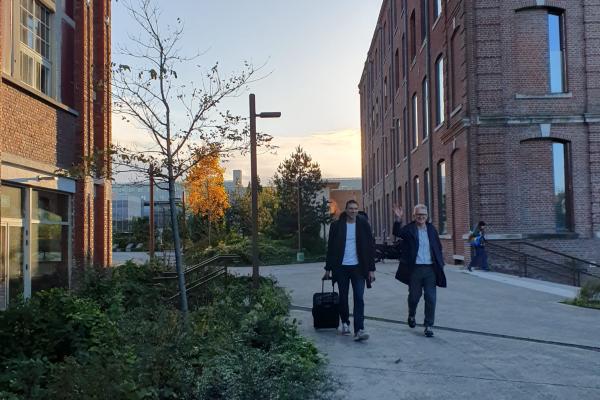
Building Innovation and Growth through Digital Economies: A City-to-City Exchange between Brno and Tallinn
And where better to tackle these questions than Tallinn (EE) which ranks highly in many different indices about various aspects of digitalisation and e-governance. With just 1.3m people, it may surprise some to hear that Estonia has the highest number of startups unicorns (businesses valued at over $1bn) and investments per capita in the EU. The startup sector grows by 30% each year and contributed €232m in employment taxes in 2023. The Brno team were keen to find out more so reached out to Tallinn’s Science and Technology Park and Municipality to see if they would be willing and able to host a City-to-City Exchange through the European Urban Initiative. After a few technical hitches and some additional support from the EUI team to identify the right people, the visit took place in April 2024 and I was fortunate to support the learning and exchange process as a C2C Moderator.
Estonia's achievements in digital transition
Goals
The team from Brno included people from both the municipality and the Technology Park. They were keen to understand some of Tallinn’s success factors and to explore whether any of these might be transferable. With an estimated population of 380,000, Brno is sometimes referred to as the Moravian Silicon Valley. It is home to a wide range of international and Czech businesses, start-ups, research centres and universities. Brno is also a young city that attracts young potential and is home to about 80,000 students. The exchange was designed to provide practical examples of innovation, entrepreneurship and smart city projects which could inform and inspire meaningful local change back in Brno. Having time away as a group also provided valuable space for new and different conversations about local stakeholder relationships.
Visits
Because Estonia is such a unique case it was important to set the scene before diving into local projects and programmes. That is why we started with a visit to the E-Estonia Briefing Centre where we learnt about the 30-year evolution of digitalisation since Estonia became independent in the early 1990’s. One of the key success factors is that every single citizen has a unique electronic identification and this is used for absolutely every digital transaction – across both the public and private sectors. Through a series of clever data integrations, this means that what might otherwise be quite complex tasks, are almost entirely automated. For example, your annual tax return is pre-populated online and all you have to do is check and submit. This takes around 2 minutes. The only thing that is not yet possible to set up or do online is divorce and this is set to change this year. In total, a massive 3322+ services, fully integrated between the public and private sectors, are delivered digitally.
Once we had this context, we went on to visit a range of different and inspirational people, places, and things. Some highlights included:
- A visit to the annual MELT Forum where we met the team behind Test in Tallinn and Tallinnnovation. Hosted by Tallinn City each year in partnership with Tehnopol – MELT is a showcase for innovative ideas and businesses and has a different theme each year. In 2024, this was Artificial Intelligence.
- Hearing about some of the incredible and somewhat mind-blowing smart city pilot projects which have come through the FinEst Centre for Smart Cities and the related work which effectively opens Tallinn up as a test bed for new smart city solutions.
- Understanding from Tehnopol the extent to which startups and innovation underpins jobs and growth strategies – perhaps typified by the massive range of startup support programmes and the different make-up of the Tallinn Technology Park and Brno’s. (Tallinn’s has 70,000m2 of space with 350+ companies whilst Brno’s has 62,000m” of space with just 40 companies).
- Visiting Mektory – part of TalTech (Tallinn’s University of Technology) which is a living and breathing example of the triple helix approach to innovation, providing innovators, students business and government with a set of useful and creative spaces to test and learn.
- Learning about just how open Tallinn is to its citizens and national and international partnerships – how this is simply accepted as the norm and how this enables what feels like a culture of curiosity from which innovation grows. This was visible everywhere we went and perhaps brought to life in the new Open City Hall where local people can pop in & explore the city’s 3D digital twin.
Learnings and actions
During our debriefs, we explored which elements of the visits were most relevant to Brno and what specific action might be considered because of the exchange and learning. Again, these are too numerous to list here but some, which are hopefully also of interest to other cities, are summarised in the table below:
Learning |
Action |
|
The culture and mindset is different - Tallinn seems open, agile and productive. |
Have more meetings; do more networking; spread the word; seek forgiveness rather than permission; accept that done is better than perfect. |
|
Programmes such as Test in Tallinn, Tallinnovation & Prototron are interesting. |
Think more about who does what; join things up better; collaborate more; try to reduce any potential sense of rivalry. |
|
Wellbeing is a priority - User experience is considered everywhere. |
Remember that we are all humans and we are more effective and efficient when we are happy. Good city and working environments matter. |
|
UNSDG’s are important to cities. |
Consider how to embed / consider SDG’s in smart city work. |
|
Triple helix approach is tangible. |
Have more meetings and networking. Talk to national ministries about how to embed triple helix approach in smart city work. |
|
The wide range of innovative smart city projects is impressive. |
Constantly remember the role that EU exchange programmes like URBACT, INTERREG and EUI can play in fostering innovation. |
|
Tallinn has a wide range of national and international partnerships with other cities. |
Proactively map existing relationships & explore new networking opportunities. |
|
The city is a living lab where companies can test and play. |
Consider this when developing new city plans. |
For me personally, I was once again reminded that digitalisation is about a lot more than technology. It relies on strong digitally-minded leadership; it needs to be easily understandable by all people and it needs to have a tangible impact on their daily lives for them to see the impact. Transparency and trust are key, and tricky, and a citizen-focused service-design approach helps to get this right. When it comes to digitalisation of public services, it is important to remember that the citizen is the user / customer – not the government.
The EUI City-to-City Exchange provided an unrivalled opportunity for the Brno Team to get under the skin of a successful and yet relatable peer city. As well as funding the trip, the EUI team were super helpful in connecting us with various local stakeholders. So, if you are considering getting involved, do not hesitate – just remember that great things come from unusual places.
Some useful links:
- https://greentallinn.eu/en/test-in-tallinn/
- https://innovatsioonifond.tehnopol.ee/en/home/
- https://finestcentre.eu/
- https://melt.ee
- https://taltech.ee/
- https://www.tehnopol.ee/en/
- https://www.tallinn.ee/en
- Www.3dtallinn.ee
Alison Partridge
EUI C2C Moderator
April 2024
